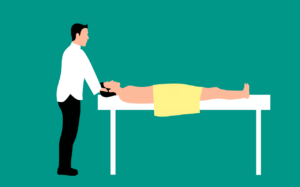
Having trouble sleeping due to neck and shoulder blade pain? Look no further! In this article, you will find practical tips and techniques to help you get better sleep despite the discomfort. Discover gentle stretches, proper sleeping positions, and additional remedies that will provide relief and promote a restful night’s sleep. Say goodbye to sleepless nights and wake up feeling refreshed and rejuvenated.

Proper Sleep Posture
Aligning the Spine
When it comes to alleviating neck and shoulder blade pain, maintaining proper sleep posture is crucial. Ensure that your spine is aligned properly while you sleep by maintaining a neutral position. This means that your head, neck, and back should be in a straight line. Avoid sleeping in a twisted or contorted position, as this can put unnecessary strain on your neck and shoulders.
Choosing the Right Pillow
Selecting the right pillow can significantly impact your sleep posture. Look for a pillow that provides adequate support for your neck and shoulders. A pillow that is too flat or too firm can lead to additional discomfort. Consider investing in a contour pillow, which is specifically designed to support the natural curvature of your neck. This can help alleviate pressure from the neck and shoulder area, promoting a more restful sleep.
Using a Supportive Mattress
In addition to a suitable pillow, using a supportive mattress is essential for maintaining proper sleep posture. A mattress that is too soft or sagging can cause your body to sink in and misalign your spine. Opt for a medium-firm mattress that offers sufficient support to keep your spine in a neutral position. This will help distribute your body weight evenly and reduce the strain on your neck and shoulder blades.
Avoiding Stomach Sleeping
Sleeping on your stomach can aggravate neck and shoulder blade pain, as it forces your head to be turned to one side for an extended period. This prolonged rotation of the neck can strain the muscles and joints, leading to discomfort and stiffness. If you are experiencing neck and shoulder pain, try to avoid sleeping in this position and opt for back or side sleeping instead.
Relaxation Techniques
Deep Breathing Exercises
Deep breathing exercises can help relax the muscles in your neck and shoulders, promoting pain relief and better sleep. Find a comfortable position, close your eyes, and take slow, deep breaths. Inhale deeply, allowing your abdomen to expand, and exhale slowly, releasing any tension in your body. Repeat this breathing pattern for a few minutes before bed to induce relaxation and alleviate neck and shoulder blade pain.
Progressive Muscle Relaxation
Progressive muscle relaxation is a technique that involves systematically tensing and relaxing different muscle groups in your body. Start by tensing your neck and shoulder muscles for a few seconds, then release the tension and focus on the sensation of relaxation. Gradually move on to other muscle groups, such as your arms, chest, and back. This technique can help loosen any tightness in your neck and shoulders, preparing your body for a more comfortable and restful sleep.
Guided Meditation
Practicing guided meditation before bed can aid in relaxing your mind and body, ultimately reducing neck and shoulder blade pain. Find a quiet and comfortable space, listen to a guided meditation recording, and allow yourself to follow the instructions. Focus on your breathing, let go of any thoughts or worries, and allow yourself to be fully present in the moment. Guided meditation can help alleviate stress, tension, and pain, promoting a more peaceful and rejuvenating sleep.
Yoga and Stretching
Engaging in gentle yoga poses or stretching exercises can help relieve tension in your neck and shoulders. Incorporate yoga or stretching into your bedtime routine to promote relaxation and reduce pain. Explore poses that target the neck and shoulder areas, such as neck stretches, shoulder rolls, and upper back stretches. These exercises can help improve flexibility, release tightness, and enhance blood circulation, contributing to a better night’s sleep.
Pain Relief Methods
Applying Heat Therapy
Applying heat therapy to your neck and shoulder area can help relax tense muscles and provide temporary pain relief. Use a heating pad, a warm towel, or take a warm bath before bedtime to soothe your neck and shoulder blade pain. The heat promotes blood flow and helps increase flexibility, easing muscle stiffness and reducing discomfort. Be cautious not to apply excessive heat directly to your skin to avoid burns or skin irritation.
Using Cold Compresses
Alternatively, cold compresses can also be effective in relieving pain and reducing inflammation in your neck and shoulders. Wrap an ice pack or a bag of frozen peas in a cloth and gently apply it to the affected area for about 15 minutes. The cold temperature can numb the pain and reduce swelling, providing you with relief and a more comfortable sleep. Remember to always wrap the cold compress in a cloth to protect your skin from direct contact with the ice.
Over-the-Counter Pain Medication
Over-the-counter pain medication, such as nonsteroidal anti-inflammatory drugs (NSAIDs) like ibuprofen or acetaminophen, can be taken to alleviate mild to moderate neck and shoulder blade pain. However, it is important to follow the recommended dosage and consult with a healthcare professional before taking any medication. While these medications can provide temporary relief, they should not be relied upon as a long-term solution for managing neck and shoulder pain.
Topical Analgesics
Topical analgesics, such as creams, gels, or ointments, can provide localized pain relief when applied directly to the affected area. These products often contain ingredients like menthol or capsaicin, which help alleviate pain and reduce inflammation. Gently massage the topical analgesic into your neck and shoulder muscles before bed to experience soothing relief. It is advisable to read and follow the instructions on the product packaging for the most effective and safe use.
Ergonomic Adjustments
Proper Workstation Setup
If you spend a significant amount of time working at a desk or computer, it is important to have a proper workstation setup that promotes good posture and minimizes strain on your neck and shoulders. Ensure that your chair, desk, and computer monitor are appropriately positioned. Your chair should support your lower back, and your feet should be flat on the floor or on a footrest. The top of your computer monitor should be at eye level to avoid excessive bending or tilting of your neck.
Maintaining Good Posture
Maintaining good posture throughout the day, whether standing or sitting, is crucial in preventing neck and shoulder blade pain. Avoid slouching or hunching your shoulders forward, as this can strain the muscles in your upper body. Instead, keep your shoulders relaxed and pulled back, and your head aligned with your spine. Be mindful of your posture and make conscious efforts to correct any poor habits. Good posture not only helps alleviate pain but also promotes overall spinal health.
Taking Regular Breaks
Taking regular breaks from prolonged sitting or repetitive tasks is essential in reducing the risk of neck and shoulder blade pain. Incorporate short breaks into your work routine to stand up, stretch, and move around. These breaks allow your muscles to relax and prevent them from becoming overly fatigued. Additionally, use these opportunities to stretch your neck and shoulder muscles, releasing any tension and promoting blood circulation.
Using Ergonomic Devices
Consider using ergonomic devices, such as an ergonomic chair, keyboard, or mouse, to support your neck and shoulder health. An ergonomic chair with adjustable features can help maintain proper posture and provide adequate lumbar support. An ergonomic keyboard and mouse can reduce strain on your wrists and shoulders, preventing discomfort and pain. These devices are specifically designed to optimize your body’s alignment and promote better ergonomics, ultimately supporting a healthier neck and shoulder region.

Sleeping Positions
Back Sleeping
Sleeping on your back is generally considered the best position for your neck and shoulders, as it allows your spine to maintain its natural alignment. To ensure proper support, use a pillow that adequately cradles your neck and head without lifting them too high. This will help avoid any strain or misalignment. Place a small pillow or rolled-up towel underneath your knees to further support your lower back and help maintain the natural curvature of your spine.
Side Sleeping
Side sleeping can also be a suitable position for neck and shoulder pain relief, especially if you prefer this position or experience snoring or sleep apnea. When sleeping on your side, use a thicker pillow to fill the gap between your neck and shoulder. This will help keep your spine aligned in a neutral position. Additionally, place a pillow between your knees to help maintain proper hip alignment and reduce strain on your lower back.
Pillow Support for Side Sleepers
For side sleepers who experience neck and shoulder blade pain, a body pillow can provide excellent support. Place the body pillow against your chest and stomach, allowing your arms to rest on it. This position helps prevent any unnecessary strain on your shoulders. The body pillow also keeps your spine properly aligned, reducing the risk of discomfort and promoting better sleep quality.
Avoiding Poor Sleeping Positions
Avoid sleeping in poor positions that strain your neck and shoulders. Sleeping on your stomach can lead to excessive twisting of the neck, causing strain on the muscles and joints. It is also best to avoid sleeping with your hand under your head, as this can induce nerve compression and contribute to pain. Be mindful of your sleeping positions and make adjustments to ensure optimal comfort and support for your neck and shoulder region.
Bedtime Rituals
Creating a Relaxing Environment
Creating a relaxing environment in your bedroom can significantly impact the quality of your sleep and reduce neck and shoulder blade pain. Ensure that your bedroom is cool, dark, and quiet, promoting a peaceful atmosphere. Eliminate any sources of noise or distraction, such as electronics or bright lights. Use comfortable bedding, such as soft sheets and a cozy blanket, to enhance your sleep experience. By creating a serene environment, you will be able to unwind and prepare for a restful night’s sleep.
Establishing a Consistent Sleep Schedule
Establishing a consistent sleep schedule is essential in regulating your body’s internal clock and promoting better sleep. Try to go to bed and wake up at the same time every day, even on weekends. This helps set a consistent rhythm for your body and improves the overall quality of your sleep. By sticking to a regular sleep schedule, you are more likely to experience less neck and shoulder blade pain and wake up feeling refreshed and rejuvenated.
Limiting Screen Time before Bed
Exposure to blue light emitted by electronic devices such as smartphones, tablets, and laptops can interfere with your sleep. The blue light suppresses the production of melatonin, a hormone that regulates sleep-wake cycles. To minimize this interference, limit your screen time at least one hour before bed. Instead, engage in relaxing activities such as reading a book, taking a warm bath, or practicing meditation. By reducing your exposure to screens, you are giving your body the chance to naturally wind down and prepare for a peaceful night’s sleep.
Avoiding Stimulants
Avoid consuming stimulants, such as caffeine and nicotine, close to bedtime. Both substances can disrupt your sleep and contribute to increased neck and shoulder blade pain. Caffeine is a stimulant found in coffee, tea, energy drinks, and chocolate. It can interfere with your ability to fall asleep and stay asleep. Nicotine, found in tobacco products, is also a stimulant that can cause restlessness and sleep disruptions. To promote better sleep, limit or avoid these substances, especially in the evening hours.

Neck and Shoulder Exercises
Neck Stretches
Performing gentle stretching exercises for your neck can help relieve tension and improve flexibility, reducing pain in that area. Tilt your head to one side, bringing your ear towards your shoulder, and hold the stretch for a few seconds. Repeat on the other side. You can also tilt your head forward, bringing your chin towards your chest, and slowly rotate your head in a circular motion. These exercises can help loosen tight muscles and promote blood circulation to the neck and shoulder region.
Shoulder Rolls
Shoulder rolls are a simple and effective exercise to relieve stiffness and tension in your shoulders. Stand or sit up straight and slowly roll your shoulders forward in a circular motion. Perform several rotations, then reverse the direction and roll your shoulders backward. This exercise helps improve blood flow and loosen the muscles in your shoulders, contributing to reduced pain and improved mobility.
Upper Back Strength Exercises
Strengthening the muscles in your upper back can help alleviate neck and shoulder pain. Perform exercises such as rows, reverse flys, or lat pulldowns with resistance bands, dumbbells, or a cable machine. These exercises target the muscles that support your neck and shoulder blades, helping to reduce strain and improve overall stability. Start with light weights and gradually increase the resistance as your strength improves.
Physical Therapy
If your neck and shoulder blade pain persist or worsen, consider seeking assistance from a physical therapist. A physical therapist can evaluate your condition, provide personalized exercises and stretches, and offer additional treatments such as manual therapy or electrical stimulation. They can also assess and address any underlying muscle imbalances or postural issues that may be contributing to your pain. Physical therapy can be a valuable resource in managing and overcoming neck and shoulder blade pain.
Sleeping Accessories
Neck Pillows and Supports
Using neck pillows or supports can provide additional comfort and relief for neck and shoulder blade pain while sleeping. Neck pillows are designed to support the natural curvature of your neck and provide stability while you rest. They help keep your head in alignment with your spine, reducing strain and promoting a more restful sleep. Consider selecting a neck pillow that suits your preferred sleeping position, whether it’s back or side sleeping.
Orthopedic Mattress Toppers
An orthopedic mattress topper can add extra support and cushioning to your current mattress, providing relief for neck and shoulder blade pain. These toppers are designed to contour to your body’s shape, helping distribute your weight evenly and reducing pressure points. They can help align your spine and alleviate discomfort, contributing to a more comfortable and supportive sleep surface. Choose a mattress topper that suits your preferences and provides the necessary support for your neck and shoulders.
Body Pillows
For those who experience neck and shoulder pain, using a body pillow can provide excellent support and pain relief. Body pillows are long, narrow pillows that can be wrapped around your body, supporting your neck, shoulders, and knees at the same time. By keeping your body properly aligned, body pillows can help reduce strain and promote a comfortable sleep position. Experiment with different body pillow shapes and sizes to find the one that works best for your specific needs.
Sleeping with a Rolled Towel
If you prefer a more budget-friendly option, rolling up a towel and placing it under your neck or shoulder can provide temporary relief and support. For example, if you sleep on your back, roll up a towel and place it under your neck to provide extra cushioning and promote proper alignment. If you sleep on your side, place the rolled-up towel between your shoulder and the mattress to fill in the gap and maintain proper spinal alignment. This simple adjustment can make a difference in reducing discomfort and improving sleep quality.
Professional Assistance
Consulting a Physical Therapist
If your neck and shoulder blade pain persists or worsens despite self-care measures, it may be beneficial to consult a physical therapist. A physical therapist can assess your condition, identify any underlying factors contributing to your pain, and provide targeted treatments to alleviate your symptoms. They may use manual techniques, provide personalized exercises, and offer additional modalities such as ultrasound or electrical stimulation to promote healing and improve your overall well-being. A physical therapist can create a tailored treatment plan to address your specific needs and guide you towards recovery.
Seeking Chiropractic Care
Chiropractic care is another option to consider when dealing with neck and shoulder blade pain. Chiropractors specialize in spinal health and can perform adjustments to relieve misalignments or subluxations in the spine. Through gentle manipulations and mobilizations, chiropractors aim to restore proper alignment, reduce nerve interference, and alleviate pain. Seeking chiropractic care can help address the root cause of your neck and shoulder blade pain, providing long-term relief and improving your overall spinal health.
Considering Acupuncture
Acupuncture, a form of traditional Chinese medicine, involves the insertion of thin needles into specific points of the body to promote healing and alleviate pain. This therapy can be beneficial for managing neck and shoulder blade pain by stimulating the release of endorphins, which are natural pain-fighting chemicals in the body. Acupuncture sessions can help reduce inflammation, improve blood flow, and restore the balance of energy throughout your body. Consider consulting a certified acupuncturist to see if this approach may be suitable for your pain management needs.
Exploring Massage Therapy
Massage therapy can provide relief for neck and shoulder blade pain by targeting and relaxing tense muscles. A skilled massage therapist can use various techniques such as Swedish massage, deep tissue massage, or trigger point therapy to alleviate your pain and tension. Massage therapy increases blood circulation, reduces muscle tightness, and promotes relaxation. Regular sessions may help improve your sleep quality, reduce pain, and enhance overall physical well-being. Consult a licensed massage therapist to explore this non-invasive treatment option.
Maintaining Overall Health
Regular Exercise
Engaging in regular exercise is important not only for your overall health but also for managing neck and shoulder blade pain. Physical activity helps improve blood flow, circulation, and flexibility, which can alleviate pain and promote better sleep. Incorporate exercises that target your neck, shoulders, and upper back into your routine, such as neck stretches, shoulder rolls, and upper back strengthening exercises. Remember to start slowly and gradually increase the intensity of your workouts. Consult a healthcare professional before starting any exercise program, especially if you have existing pain or medical conditions.
Maintaining a Healthy Weight
Maintaining a healthy weight is crucial for preventing or managing neck and shoulder blade pain. Excess weight can put additional strain on your spine and joints, exacerbating pain and discomfort. By adopting a balanced diet and engaging in regular exercise, you can achieve and maintain a healthy weight. This healthy lifestyle will not only contribute to reduced pain but also improve your overall well-being and sleep quality.
Balanced Diet
Eating a balanced diet rich in nutrients can support your overall health, including your neck and shoulder region. Include foods that are high in antioxidants and anti-inflammatory properties, such as fruits, vegetables, whole grains, and lean proteins. Adequate hydration is also essential to keep your muscles and joints lubricated. Avoid or limit the consumption of processed foods, sugary snacks, and inflammatory substances like alcohol and caffeine. A well-rounded diet can help reduce inflammation, promote tissue healing, and contribute to better neck and shoulder health.
Stress Management
Chronic stress can contribute to muscle tension and exacerbate neck and shoulder blade pain. Implementing stress management techniques into your daily routine can help alleviate pain and improve sleep quality. Practice relaxation exercises such as deep breathing, meditation, or yoga to reduce stress levels. Engage in activities that you enjoy, such as listening to music, spending time in nature, or engaging in hobbies, to promote relaxation and foster a positive mindset. Addressing stress and finding healthy coping mechanisms can have a significant impact on managing neck and shoulder pain and promoting better overall health.
By incorporating these tips into your daily routine, you can make significant progress in managing and relieving neck and shoulder blade pain. Remember, it is important to consult with a healthcare professional or specialist if your pain persists or worsens. Prioritize restful sleep, relaxation techniques, and a healthy lifestyle to support your neck and shoulder health and enhance your overall well-being.







